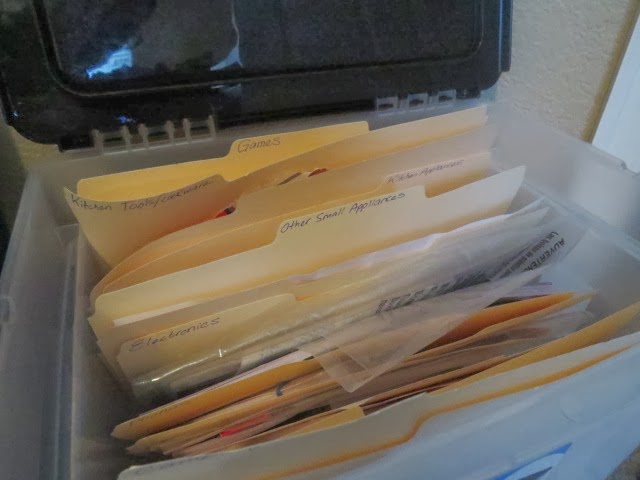Have you ever thrown them out, only to have problems with the product down the road?
Find yourself wishing you had not tossed that warranty into the recycle bin?
Fumbling with your digital camera and can't get the settings right without the owner's manual?
Have you actually held on to all those papers, but they're cluttering up your home & you never know where to find them?!
Here's the inexpensive solution we've been using at our house for about 3 years, and it has worked rather well for us.
Supplies:
File bin or filing cabinet
Manila file folders
Hanging files
Plastic food storage bags (quart or gallon)
Felt tip pen
We put all the important papers related to products we own, as well as backup software discs and receipts for the really important stuff in a file bin. These files can be organized & labeled by the room you keep the item in, what type of product it is, or you can even have a separate folder labeled for each item and alphabetize them.
Here's how we've organized our bin:
Camping and Recreation Gear
Baby Gear
Pet Gear
Jewelry
Toys
Games
Tools
Furniture
Kitchen Tools/Cookware
Kitchen Appliances
Other Small Appliances
Camera
Computer and Software
Printers
Computer Accessories
Phone
Other Small Electronics
Miscellaneous
You can label some folders this way and start using this system at your house for the cost of a quick trip to the dollar store!
Choose to specify your folders however you like specific to your situation. For example, if you have a large collection of firearms, you might sort them by pistols, shotguns, and rifles. (By the way, it is important to have written down somewhere the serial numbers in case of theft).
Staple receipts and product warranties that go with the same item together. Plastic storage bags are good if you have a tiny part, disc, or tiny slip of paper that you need to hang on to. These can also be labeled with a felt tip pen.
It's a good idea to photocopy receipts onto a standard sheet of paper, but since manufacturers may require an original receipt in order to service or replace your product you should staple them together and keep both.
Consider carefully what should and should not go in your bin, so you do not hold on to mere clutter. Do you really need to save the instructions for that basic $9 drip coffee maker that does not even boast an auto function or clock? You may not need to save a warranty for an item that was very inexpensive to begin with, if you're sure you would not try to contact the manufacturer if it were to break. Remember, the point is try to clear your home of clutter.
Examples of some other things that should not go in this bin might include instructions for using your jumper cables (unless you're a mechanic, keep them in the car!), or instructions for setting up your tent (keep it with the tent!).
This system should work well for most households, but only if you maintain it.
- Put the instructions in the file as soon as you've finished using them.
- Clean out the file bin at least once year, tossing anything that goes with...say...and appliance you no longer own. I try to clean out all my files between the New Year and tax season.
..........
A place for everything, and everything in it's place. Now doesn't that feel better? Good luck, y'all!

No comments:
Post a Comment